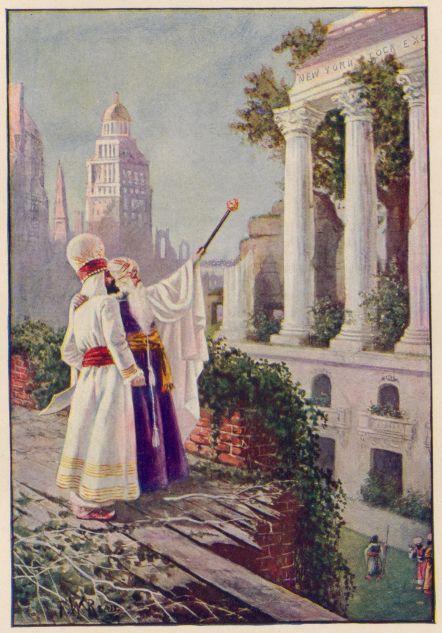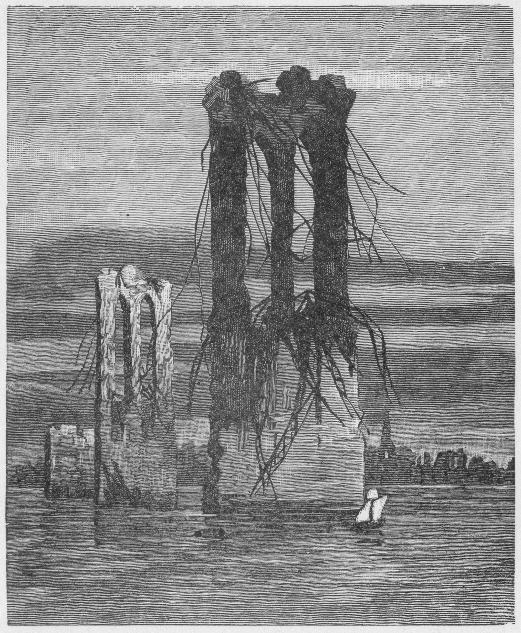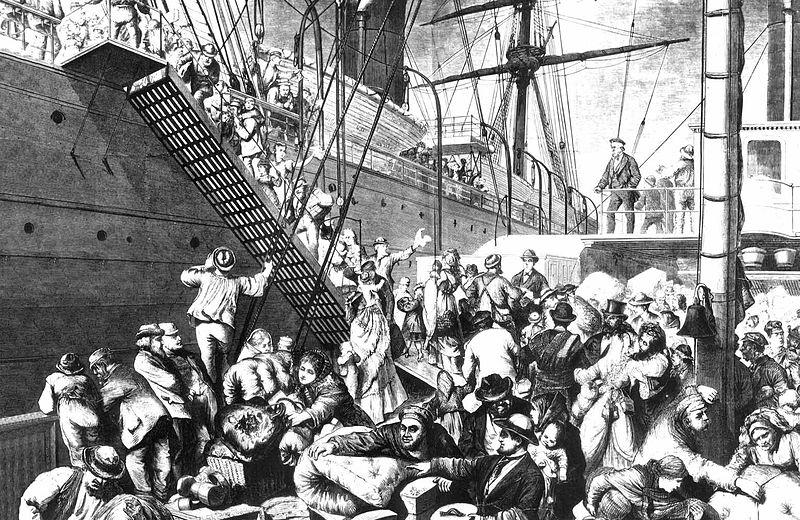
“ ‘The knowledge we sought’; and he pointed to the inscription.” Illustration by FW Read.
 This work is licensed under a Creative Commons Public Domain Mark 1.0 License.
This work is licensed under a Creative Commons Public Domain Mark 1.0 License.
Mitchell, John Ames. The Last American: A Fragment from the Journal of Khan-Li, Prince of Dimph-Yoo-Chur and Admiral in the Persian Navy. Illustrated by John Ames Mitchell and F.W. Read. New York: Frederick A. Stokes, 1902.
In this fictional future history, written by the co-founder of Life magazine, the Persian prince and admiral Khan-Li records his astonishing journey through the ruins of “Nhu-Yok,” the famed city of the extinct “Mehrikan” people. Once among the most spectacular cities in the world, New York City has become a wilderness. Khan-Li and his crew enter an “ancient street, the pavements covered with weeds, grass and flowers, all crowding together in wild neglect. Huge trees of great antiquity thrust their limbs through windows and roofs and produced a mournful effect.”

“The Two Monuments in the River.” Illustration by John Ames Mitchell.
 This work is licensed under a Creative Commons Public Domain Mark 1.0 License.
This work is licensed under a Creative Commons Public Domain Mark 1.0 License.
One of the city’s most marvelous technological feats, the Brooklyn Bridge, now stands broken in the East River, a mysterious monument to failed human endeavors. The Persians are baffled: “We sailed close under one of the great monuments in the river, and are at a loss to divine its meaning. Many iron rods still dangle from the tops of each of the structures.”
What caused the decline of “Mehrikan” civilization? Like other “future historians” of the late nineteenth century, Mitchell used the fantastic image of US collapse as a means of cautioning the nation against looming crises. Mitchell’s view of the United States’ most troubling tendencies is a curious blend of xenophobia, Darwinism, anti-modernism, and climatology:
The Mehrikans themselves were of English origin, but people from all parts of Europe came here in vast numbers. Although the original comers were vigorous and hardy the effect of climate upon succeeding generations was fatal. They became flat-chested and thin, with scanty hair, fragile teeth, and weak digestions. Nervous diseases unknown to us wrought deadly havoc. […] Climatic changes, the like of which no other land ever experienced, began at that period, and finished in less than ten years a work made easy by nervous natures and rapid lives. The temperature would skip in a single day from burning heat to winter’s cold. No constitution could withstand it, and this vast continent became once more an empty wilderness.
— Mitchell, The Last American

“From the Old to the New World.” Harper’s Weekly, 1874. Public domain.
 This work is licensed under a Creative Commons Public Domain Mark 1.0 License.
This work is licensed under a Creative Commons Public Domain Mark 1.0 License.
Looking back on Mitchell’s work today, we can see that his major concern was not really the future, but his own present. He was worried about the great waves of Germans, Russians, Irish, and Italians emigrating to US metropolises; he was distressed by the “nervousness” created by the pace of modern life; and, perhaps most surprisingly of all, he was concerned about the weather.
In addition to the full text below, the color version can be found on the Project Gutenberg website. This eBook is for the use of anyone anywhere at no cost and with almost no restrictions whatsoever. You may copy it, give it away or re-use it under the terms of the Project Gutenberg License included with this eBook or online at www.gutenberg.net.
- Yablon, Nick. Untimely Ruins: An Archaeology of American Urban Modernity, 1819-1919. Chicago: University of Chicago Press, 2009.

